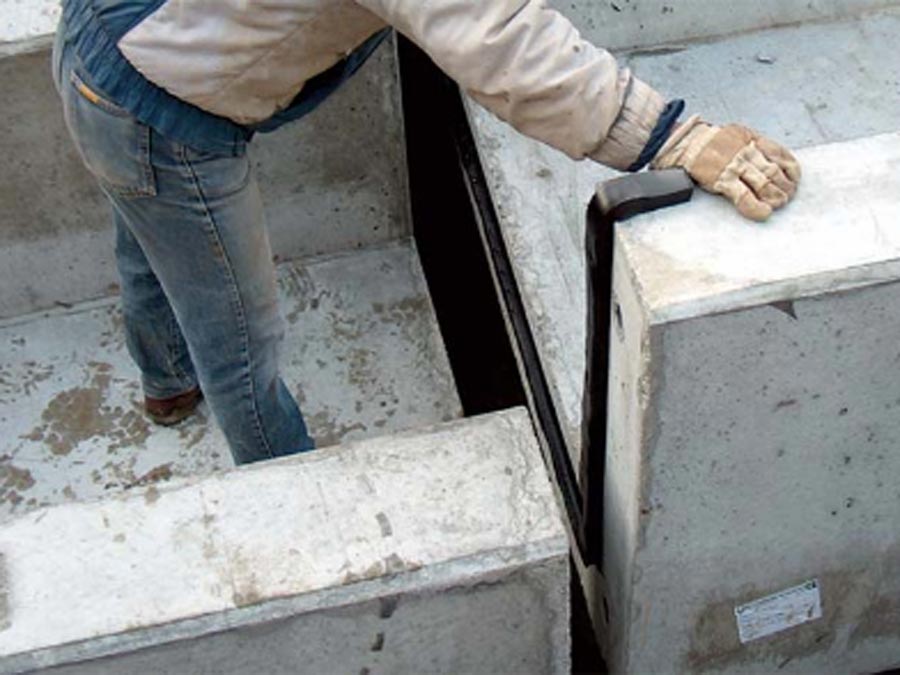
Image credit: https://sylvan-products.com/product/rubber-elast-sealing-strip/
How to Glue Rubber to Concrete
In this guide on how to glue rubber to concrete, we share the best types of glue and the step-by-step walkthrough of how to do it. There are three good adhesives to select when gluing rubber to concrete. These adhesives include silicone, polyurethane, and epoxy resin, and each of these will require a specific brand suggestion.
Because concrete and rubber surfaces are completely opposite to each other, learning how these adhesives will help them to stick together is vital. Some preparations will increase the bond depending on the adhesive chosen and we do have similar posts about gluing concrete and metal together that is worth reading.
The best choice for each adhesive will be a matter of application ease and curing considerations. It can also help work on a budget if rubber pieces are not very large and may need to be glued in a short period.
What Glue Can You Use for Rubber to Concrete?
Whether you are installing rubber safety bumpers or installing a concrete seal with rubber tubing you need a glue that will hold tight on both surfaces. While this is a tricky combination and nothing works 100%, these are three of the glues we would use for rubber and concrete:
Polyurethane Adhesive
Not just any polyurethane adhesive is used for gluing rubber to concrete. Because concrete is a material that readily absorbs moisture from the air, the recommended polyurethane adhesive must be a construction-grade glue that’s intended for applications in gluing rubber floor matting, weather stripping, and flooring. The best product names include Gorilla Glue Construction Adhesive, Liquid Nails LN-950, and 3M construction adhesive.
Polyurethane adhesive is good to use on concrete since there is moisture that helps the glue to complete its curing cycle. This makes it an excellent choice for long-term adhesion which is best for gluing rubber to concrete.
Epoxy Resin
The option to use epoxy resin to glue rubber to concrete is solved by using specific epoxy formulations. Since there are slight differences between epoxy resin formulations, the type of epoxy that works best for gluing rubber to concrete needs to be semi-flexible. Brands that include Copps K-550 and Hardman epoxy resin are special since they don’t degrade the rubber. There are special preparations for the rubber material being glued down likewise.
Using epoxy resin adhesive for gluing rubber to concrete will be easier for smaller items such as sections of rubber used for a standing matt.
Silicone Adhesive
A good option for gluing rubber to concrete will be silicone adhesive. These adhesives will include special formulations meant for landscaping and construction applications. Look for Roof and gutter adhesive or even Liquid Nails landscape silicone adhesive. These two are great choices and won’t damage the rubber while it cures. These adhesives are somewhat flexible and provide excellent grip on concrete and rubber surfaces.
There will be some preparation that is used to rubber to keep the silicone adhesive attached to the rubber. This silicone adhesive is excellent for areas that could be affected by moisture or water that concrete tends to absorb.

Image credit: https://sylvan-products.com/product/rubber-elast-sealing-strip/
How to Prepare Rubber to Concrete Before Gluing
The area of concrete that is intended to be glued must be as flat as possible with very few surface defects. Not glass smooth but with relative texture. Sweep the area clear where the rubber will be glued down. If using polyurethane glue, the surface of the concrete floor should be sprayed with a light layer of water to help activate and cure the polyurethane glue.
Any rubber surface should be prepped by sanding the bonding side with sandpaper to give it some texture. This helps with bonding unless the underside of a rubber piece already has surface texture. Both rubber and concrete surfaces need to be clean and free of dirt.
How to Apply Glue for Rubber to Concrete
Using a large spatula or spackle trowel is the best way to spread the adhesive onto the concrete. Afterward, the rubber is laid onto the surface and air bubbles are pressed out using a rolling pin or anything flat that can roll on its side including gallon-size paint cans or a section of heavy rounded pipe. Polyurethane glue and epoxy resin work best using a plastic squeegee from a paint store while thicker silicone adhesive is best using a spackle trowel.
Since silicone adhesive will often contain a solvent that smells acidic, it’s best to spread this glue quickly and lay down the rubber in sections. The rooms should be well-ventilated to prevent odors and fumes from building up.
How to Cure Rubber to Concrete Glue
Polyurethane adhesive is moisture sensitive and will start to cure when there is damp concrete. This begins the curing process that will take the next 4-5 hours to cure with a 24-hour post-cure that’s needed. Epoxy is a chemical cure that can take at least half a day to cure but will accelerate if the room is above 75 degrees Fahrenheit. Silicone adhesive is sped-up with air but when rubber is glued over concrete, the curing takes longer.
It’s best to allow the silicone to set up and cure for at least 24 hours at the minimum. Adding heat to a room where silicone is being cured can help with the curing, but isn’t necessary to speed up silicone curing by itself.
Which Is the Best Glue to Use?
In terms of overall strength, polyurethane and silicone adhesives are excellent since they provide a rubberized adhesion that can last for several years. Epoxy resin is a good choice if you purchase a specialized brand that gives a semi-flexible bond that won’t shrink or crack. It will be easier to spread epoxy and polyurethane as opposed to silicone glue. The only downside to silicone adhesive is that air will cause it to cure quickly.
When time is allowed, both polyurethane and epoxy will provide enough time to work. Silicone needs to be spread very quickly so rubber pieces can be laid down as soon as possible.










